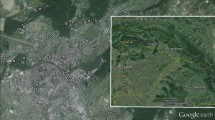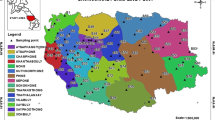Abstract
Natural radionuclides K, Th and U were evaluated for the first time on volcanic soils of Fogo Island (Cape Verde) aiming to contribute for the background concentration of radiogenic elements in these soils, assessing radiation risk, and allowing accurate chronological luminescence studies. Potassium and particularly U appear to be more mobilized in the older soils, with a high radon loss when compared to recent ones. External dose rate varies between 0.97 and 3.47 Gy/y. The results obtained in this work are a benchmark for further studies, particularly for the evaluation of modifications due to the 2014–2015 volcanic episode on Fogo Island.



Similar content being viewed by others
References
UNSCEAR (2008) Sources and effects of ionizing radiation. United Nations Scientific Committee on the effects of atomic radiation. Annex B: exposures of the public and workers from various sources of radiation, vol I. United Nations Publications, New York
Singh J, Singh H, Singh S, Bajwa BS, Sonkawade RG (2009) Comparative study of natural radioactivity levels in soil samples from the upper Siwaliks and Punjab, India using gamma-ray spectrometry. J Environ Radioact 100:94–98
Ngachin M, Garavaglia M, Giovani C, Kwato Njock MG, Nourreddine A (2008) Radioactivity level and soil radon measurement of a volcanic area in Cameroon. J Environ Radioact 99:1056e–1060e
Aitken MJ (1999) Archaeological dating using physical phenomena. Rep Prog Phys M J Aitken Rep Prog Phys 62:1333–1376
Trindade MJ, Prudêncio MI, Burbidge CI, Dias MI, Cardoso G, Marques R, Rocha F (2013) Distribution of naturally occurring radionuclides (K, Th and U) in weathered rocks of various lithological types from the uranium bearing region of Fornos de Algodres, Portugal. Mediterr Archaeol Archaeom 13(3):71–79
Trindade MJ, Prudêncio MI, Burbidge CI, Dias MI, Cardoso G, Marques R, Rocha F (2014) Study of an aplite dyke from the Beira uraniferous province in Fornos de Algodres area (Central Portugal): trace elements distribution and evaluation of natural radionuclides. Appl Geochem 44:111–120
Kapanadze K, Magalashvili A, Imnadze P (2019) Distribution of natural radionuclides in the soils and assessment of radiation hazards in the Khrami Late Variscan crystal massif (Georgia). Heliyon 5:e01377
Popic JM, Oughton DH, Salbu B, Skipperud L (2020) Transfer of naturally occurring radionuclides from soil to wild forest flora in an area with enhanced legacy and natural radioactivity in Norway. Environ Sci Process Impacts 22:350–363
Agar O, Eke C, Boztosun I, Korkmaz ME (2015) Determination of naturally occurring radionuclides in soil samples of Ayrancı, Turkey. J Phys Conf Ser 590:012042
Yasmin S, Barua BS, Khandaker MU, Kamal M, Rashid MdA, Sani SFA, Ahmed H, Nikouravan B, Bradley DA (2018) The presence of radioactive materials in soil, sand and sediment samples of Potenga sea beach area, Chittagong, Bangladesh: geological characteristics and environmental implication. Results Phys 8:1268–1274
Leal ALC, Lauria DC, Ribeiro FCA (2020) Natural radionuclide levels and the associated radiological risks in soils from the three mesoregions of Pernambuco state, Brazil. J Radioanal Nucl Chem 324:521–531
Mehra R, Kumar S, Sonkawade R, Singh NP, Badhan K (2010) Analysis of terrestrial naturally occurring radionuclides in soil samples from some areas of Sirsa district of Haryana, India using gamma ray spectrometry. Environ Earth Sci 59:1159–1164
Karo RM, Marpaung H, Gultom J, Pudjadi E, Siburian R (2017) The influence of Mount Sinabung volcanic ash and phoshate fertilizers on natural radionuclide content in agricultural soils. Chem Sci Rev Lett 6(24):2448–2452
Ramsiya M, Joseph A, Eappen KP, Visnuprasad AK (2019) Activity concentrations of radionuclides in soil samples along the coastal areas of Kerala, India and the assessment of radiation hazard indices. J Radioanal Nucl Chem 320:291–298
Marques R, Prudêncio MI, Waerenborgh JC, Rocha F, Dias MI, Ruiz F, Ferreira da Silva E, Abad M, Muñoz AM (2014) Origin of reddening in a paleosol buried by lava flows in Fogo island (Cape Verde). J Afr Earth Sci 96:60–70
Marques R, Waerenborgh JC, Prudêncio MI, Dias MI, Rocha F, Ferreira da Silva E (2014) Iron speciation in volcanic topsoils from Fogo island (Cape Verde)—iron oxide nanoparticles and trace elements concentrations. CATENA 113:95–106
Murray AS, Aitken MJ (1988) Analysis of low-level naturally occurring radioactivity in small samples for use in thermoluminescence dating using high resolution gamma spectrometry. Int J Appl Radiat Isot 39:145–158
Guibert P, Lahaye C, Bechtel F (2009) The importance of U-series disequilibrium of sediments in luminescence dating: a case study at the Roc de Marsal cave (Dordogne, France). Radiat Meas 44:223–231
Reis MC (2007) A Radioactividade no Ambiente. Gazeta de Fisica 30:58–66
Le Bas TP, Masson DG, Holtom RT, Grevemeyer I (2007) Slope failures of the flanks of the southern Cape Verde Islands. In: Lykousis V, Sakellariou D, Locat J (eds) Submarine mass movements and their consequences, Springer (pp 337–345)
Mota Gomes A (2006) A problemática da Geologia e dos Recursos Hídricos na Ilha do Fogo. Relatório inédito, Praia
Olehowski C, Naumann S, Fischer D, Siegmund A (2008) Geoecological spatial pattern analysis of the island of Fogo (Cape Verde). Glob Planet Change 64:188–197
Madeira J, da Silveira BA (2005) Geomorphic and structural analysis of the Fogo Island Volcano (Cape Verde). In: Abstract volume of SAL2005 international workshop on ocean island volcanism, Sal, Cape Verde
Madeira J, Munhá J, Tassinari CGC, Mata J, da Silveira BA, Martins S (2005) K/Ar ages of carbonatites from the island of Fogo (Cape Verde). In: Actas da XIV Semana da geoquímica e VII Congresso de geoquímica dos países de língua Portuguesa, pp 475–478
Torres PC, Madeira J, Silva LC, da Silveira BA, Serralheiro A, Mota Gomes A (1998) Carta geológica da ilha do Fogo (República de Cabo Verde). In: Erupções históricas e formações enquadrantes. LATTEX, Departamento de Geologia da Fac. de Ciências da Univ. de Lisboa, Escala, pp 1–25000
Darnley AG (1990) International geochemical mapping a new global projet. J Geochem Explor 391(1/2):1–14
Darnley AG, Björklund A, Bölviken B, Gustavsson N, Koval PV, Plant JA, Steenfelt A, Tauchid M, Xuejing X (1995) A global geochemical database for environmental and resource management. In: Recommendations for international geochemical mapping final report of IGCP project 259. UNESCO Publishing
Govindaraju K (1994) Compilation of working values and sample description for 383 geostandards. Geostand Newsl 18:1–158
Marques R, Prudêncio MI, Freitas MC, Dias MI, Rocha F (2017) Chemical element accumulation in tree bark grown in volcanic soils of Cape Verde—a first biomonitoring of Fogo Island. Environ Sci Pollut Res 24(13):11978–11990
Prudêncio MI, Roldán C, Dias MI, Marques R, Eixea A, Villaverde V (2016) A micro-invasive approach using INAA for new insights into Palaeolithic flint archaeological artefacts. J Radioanal Nucl Chem 308:195–203
Sanjurjo-Sánchez J, Montero Fenollós JL, Prudêncio MI, Barrientos V, Marques R, Dias MI (2016) Geochemical study of beveled rim bowls from the Middle Syrian Euphrates sites. J Archaeol Sci Rep 7:808–818
Richter D, Zink A, Przegietka K, Cardoso GO, Gouveia MA, Prudêncio MI (2003) Source calibrations and blind test results from the new Luminescence Dating Laboratory at the Instituto Tecnológico e Nuclear, Sacavém, Portugal. Anc TL 21(1):1–7
Burbidge CI, Trindade MJ, Cardoso GJO, Dias MI, Oosterbeek L, Cruz A, Scarre C, Cura P, Caron L, Prudêncio MI, Gouveia A, Franco D, Marques R (2014) Luminescence dating and associated analyses in transition landscapes of the Alto Ribatejo, Central Portugal. Quat Geochronol 20:65–77
Rodrigues AL, Dias MI, Valera AC, Rocha F, Prudêncio MI, Marques R, Cardoso G, Russo R (2019) Geochemistry, luminescence and innovative dose rate determination of a Chalcolithic calcite-rich negative feature. J Archaeol Sci Rep 26:101887
Erramli H (1986) Dosimetry techniques applied to thermoluminescent age estimation. Clermont-Ferrand-2 Univ., 63-Aubiere (France). Lab. de Physique Corpusculaire
Aitken MJ (1985) Thermoluminescence dating: past progress and future trends. Nucl Tracks Radiat Meas 10(1–2):3–6
Pérez-Garrido C (2020) eM-Age (excel macro for age calculation), a new application for luminescence age calculation based on Dose Rate and Age Calculator (DRAC) and analyst. Anc TL 38:1–4
Aitken MJ (1998) An introduction to optical dating: the dating of quaternary sediments by the use of photon-stimulated luminescence. Oxford Science Publications, Oxford, p 267
Guérin G, Mercier N, Nathan R, Adamiec G, Lefrais Y (2012) On the use of infinite matrix assumption and associated concepts: a critical review. Radiat Meas 47(9):778–785
Mejdahl V (1987) Internal radioactivity in quartz and feldspar grains. Anc TL 5:10–17
Rudnick RL, Gao S (2003) Composition of the continental crust. In: Rudnick RL (ed) Treatise on geochemistry, vol 3. Elsevier, Amsterdam, pp 1–64
Marques R, Prudêncio MI, Dias MI, Russo D, Marques JG, Ruiz F, Abad M, Izquierdo T, González-Regalado ML, Rocha F (2020) Paleoweathering of intrusive carbonatites (4.5 Ma) from Fogo Island, Cape Verde—mineralogy and geochemistry. CATENA 194:104778
Kogarko LN, Sorokhtina NV, Kononkova NN, Klimovich IV (2013) Uranium and thorium in carbonatitic minerals from the Guli Massif, Polar Siberia. Geochem Int 51(10):767–776
Neves MO, Figueiredo VR, Abreu MM (2012) Transfer of U, Al and Mn in the water–soil–plant (Solanum tuberosum L.) system near a former uranium mining area (Cunha Baixa, Portugal) and implications to human health. Sci Total Environ 416:156–163
Marques R, Prudêncio MI, Abreu MM, Russo D, Marques JG, Rocha F (2019) Chemical characterization of vines grown in incipient volcanic soils of Fogo Island (Cape Verde). Environ Monit Assess 191:128
National Council on Radiation Protection and Measurements (NCRP) (1987) Exposure of the population in the United States and Canada from Natural Background Radiation, NCRP report no. 94, Maryland
Acknowledgements
Grateful acknowledgments are made to the Laboratory of Nuclear Engineering (LEN) and to the staff of the Portuguese Research Reactor (RPI) of CTN/IST for their assistance with the neutron irradiations. Rosa Marques acknowledge Dr. Christopher Burbidge for his guidance during her Ph.D. work. Research funded by Fundação para a Ciência e a Tecnologia (FCT, Portugal) through the projects UIDB/04035/2020, UIDB/04349/2020, and post-doctoral grant SFRH/BPD/114986/2016.
Author information
Authors and Affiliations
Corresponding author
Additional information
Publisher's Note
Springer Nature remains neutral with regard to jurisdictional claims in published maps and institutional affiliations.
Rights and permissions
About this article
Cite this article
Marques, R., Prudêncio, M.I., Russo, D. et al. Evaluation of naturally occurring radionuclides (K, Th and U) in volcanic soils from Fogo Island, Cape Verde. J Radioanal Nucl Chem 330, 347–355 (2021). https://doi.org/10.1007/s10967-021-07959-7
Received:
Accepted:
Published:
Issue Date:
DOI: https://doi.org/10.1007/s10967-021-07959-7




